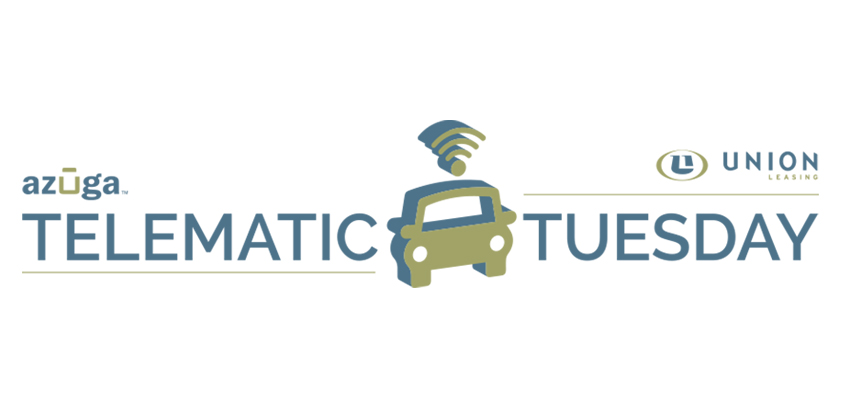Why Fleet Managers Should Monitor Hard Braking & Acceleration
We have joined forces with one of our partners, Azuga, to bring you a series focusing on the telematics aspect of managing your companies’ fleet of vehicles. Over the next several weeks, we will be sharing multiple articles, giving you tips and advice on how to add and use this tool to improve your fleet management process. Today we focus on monitoring hard breaking & acceleration, and the impact it has on your fleet.

Fleet drivers understand how to maneuver their vehicle through conditions of all varieties and even avoid less experienced drivers. While this experience helps drivers stay safe on the road, it also has an adverse effect. Driving can often be daunting, tiring, frustrating, and challenging. The longer you’re on the road, the more these emotions heighten. This may push fleet drivers into aggressive behaviors such as rapid acceleration and hard braking.
These behaviors may seem minor and common, but they have a huge impact on your fleet. It’s not just about safety, but about your company’s bottom line. But is your fleet really at risk? How do you monitor a driver’s behavior? And, how do you protect your fleet from the risks of poor driving behavior? We’ll cover that and more below.
What is Hard Driving?
Hard driving is any sudden change in vehicle behavior. This includes sudden braking, rapid acceleration, and hard cornering. Hard braking is the act of applying more force to a braking system than normal or recommended. Excessive acceleration is the application of more-than-normal force to the accelerator.
Hard braking is common and often unavoidable. Though there are cases of drivers not paying attention and needing to brake quickly as a result. If you’re monitoring driver behavior, you’ll have to expect that all drivers will brake harshly at some point in time. However, if a driver is doing this outside of the normal rate, it should raise a flag. Hard acceleration is less common, and shouldn’t be acceptable unless an accident has occurred. The most common instances of rapid acceleration are at stoplights. Heavy trucks cannot slow as quickly as regular vehicles. Meaning, their “point of no return” is much further back from the intersection. If street lights change quickly in an area, a driver may not make it through the intersection before the light changes to red. While heavy truck drivers don’t always have the ability to stop quickly, there are cases where they don’t try. Instead, they accelerate to get through the intersection in an attempt to beat the light.
Why Fleet Safety & Risk Management is Important
Big trucks have a much harder time maneuvering and braking than other vehicles. An 18-wheeler can haul up to 40 tons and is shouldn’t come as a surprise to know they can’t stop at a moment’s notice. If they try, it can easily result in an accident. At the very least, it makes conditions for other drivers on the road much more precarious.
It takes at least six seconds for a truck traveling at 55 mph to stop. In that time they’ll travel 510 feet, which is almost twice the length of a football field. While sudden braking isn’t always avoidable, it may indicate a driver is facing too many types of distractions. Hard corning, speeding, swerving, and excessive acceleration are less acceptable. These behaviors impact your fleet in many ways.
Accidents
A greater risk of accidents is a fairly obvious point, but it stands worthy of mentioning. There are many things that impact driver behavior on the road. This includes substance abuse, distractions, drowsiness, and aggressive driving as the most common causes of accidents. Distracted driving alone caused 3,166 fatalities in 2017. Drowsy driving resulted in 90,000 accidents that same year. In 2016, accidents as a result of speeding claimed the lives of 10,000 people.
This is why anticipating weather, avoiding distractions, and driving cautiously are so vital. It’s not just about the safety of the drivers, but of those around them.
Fuel Costs & Maintenance
Fuel accounts for more than 60% of most fleet budgets. Eliminating hard braking and acceleration can improve fuel consumption by three miles per gallon. Also, fixing aggressive driving issues in your fleet lowers your maintenance costs. When drivers strain their brakes or turn too sharply it can cause unwanted wear on your fleet vehicles. It’s not just your brakes and tires, this could cause deterioration in springs, suspension, and shock absorbers. Poor driving behavior could even ruin the oil much faster. The cost of maintaining a vehicle is high and a focus on preventative maintenance helps, but even those costs could take a toll on your budget. These costs will quickly add up, especially if you’re tuning up the vehicle more often than you need to.
Increased Violations and Lower CSA Scores
Poor driving behavior leads to a greater risk of accidents, citations, and safety violations. All of which lower compliance, safety, and accountability (CSA) scores. A CSA score includes the number of inspections, accidents, out-of-service periods, and more. Lower CSA scores lead to loss of consumer confidence and even company revenue. Potential customers use this information to decide which company they’d like to work with. If you’re not meeting basic safety standards, you’re either losing customers or not seeing growth.
Costs
Costs are always a focus and adhering to a budget is a number one priority for fleet managers. Encouraging safety helps keep your drivers secure and satisfied in their position. You won’t lose drivers to injuries and lawsuits from accidents. Drivers also feel protected and cared for and therefore less likely to leave. It costs companies an average of $15,000 to hire new employees, which means retaining your reliable drivers can save you tens of thousands each year.
There is, of course, the costs you save with lower maintenance needs and fewer accidents. You’ll avoid lawsuits, worker compensation payouts, and high insurance costs. Insurance companies use CSA scores and other factors to calculate your premiums. When you have a lower CSA score and safety features such as dashcams and telematics, you save on premiums.
As an industry, fleet companies lose around $60 billion annually to accidents. This includes property damage, medical expenses, loss of productivity, and clients. It does not include the damage to those affected by a loss of life. When you focus on safety, you not only save lives, but fleet managers will end up saving business costs in the long run.
How to Improve Driver Safety, Training, and Behavior
The best way to reduce accidents and mitigate fleet risk, is to use telematics devices. Telematics and fleet tracking devices monitor driver behavior and engine diagnostics in real time. It also builds trend reports for each driver, allowing you to see where you can improve your fleet. This greater visibility makes it easier to design safety and expertly-tailored training programs. It also helps you stay compliant through inspections with electronic logging of HoS, driver records, and maintenance.
We hope you found this information from our partners at Azuga very beneficial. If you’d like to learn more about the Azuga product, and how we are able to implement it into your fleet management program at Union Leasing, please contact us.
In the meantime, keep on the look out for our final collaborative telematic blog in the coming weeks.


